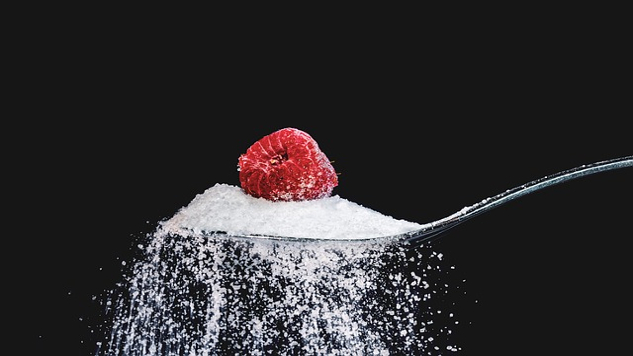
Image by Myriams-Fotos
Most of us have been raised on a carbohydrate-based diet, which means we’re slaves to glucose. As your body digests starches, glucose is the result. You’re probably familiar with the terms blood glucose or blood sugar? That’s simply the measure of glucose in your bloodstream as your body transports it. And insulin is the hormone that helps to move glucose from your blood into your cells for energy and storage.
We may be slaves to other forms of sugar, too, including fructose, found in fruit. After decades of eating grains and sugars, being exposed to chemicals, pesticides, synthetic food additives, and worn down by emotional stress, most of us are likely experiencing some degree of adrenal fatigue, more accurately known as “hypothalamic-pituitary-adrenal (HPA) axis syndrome.” We’re also heavily prone to hypoglycemia, insulin resistance, and diabetes.
Sugar and Cholesterol
If you don’t eat every few hours, do you get cranky or hangry (hungry and angry)? Do you experience mood swings, headaches, brain fog, fatigue, sugar cravings, trouble sleeping, or low productivity? Do you reach for stimulants like coffee, tea, sugar, and chocolate just to get through those mid-morning and mid-afternoon slumps? If so, it’s really quite simple: You’re responding to your body’s addiction to sugar. Numerous researchers have hypothesized that excess fructose consumption is a primary cause of insulin resistance and obesity—alongside elevated LDL cholesterol and triglycerides—leading to metabolic syndrome. That’s right, it’s the sugar—not the good fats—that increase your cholesterol.
Americans, Europeans, Central and South Americans, and Asians eat a ton of sugar. Sugar has spread all across the world. Refined white cane sugar, raw sugar, fruit sugar, brown sugar, corn sugar, milk sugar, beet sugar, alcohol, monosaccharides, disaccharides, and polysaccharides—the $100 billion/year sugar industry promotes them all. In the US, we consume an average of 150 pounds per person, per year.
I remember sprinkling white sugar on my Cheerios as a child and dipping strawberries in it. A friend’s mom made her sugar sandwiches for lunch. I’m sure you have your own memories of your favorite sweet treats growing up. But for something so yummy tasting, sugar has terrible health consequences and a surprisingly sordid past. To learn more about the dark historical and political past of the economics of sugar (a story that involves wealthy trade empires and opium) please consider reading Sugar Blues by William Dufty.
Sugar = Health Havoc
There is mounting evidence that sugar—not fat—is the leading cause of cardiovascular disease, obesity, kidney disease, diabetes, and metabolic syndrome. Sugar can also contribute to other problems, such as migraines, immune system suppression, hyperactivity in children, kidney damage, acidifying the blood, tooth decay, advanced aging, digestive disorders, arthritis, asthma, Candida albicans, decreased blood flow to the heart, food allergies, eczema, atherosclerosis, free radical formation, loss of enzyme function, increased liver and kidney size, brittle tendons, migraines, blood clots, and depression.
Dr. Weston Price, the dentist known for his landmark work Nutrition and Physical Degeneration, traveled around the world in the 1930s examining the teeth and skulls of every “primitive” (translate low-tech and isolated) race he could find—First Nations Americans, Swiss Alps villagers, Alaskan Inuits, Australian aboriginal people, Fiji islanders, and more. What he discovered was that when people in previously isolated traditional societies were introduced to Western foods such as white sugar and white flour, within only a few years, they would start experiencing “diseases of civilization”—tooth decay, tuberculosis, arthritis, obesity, and such—at rates comparable to people in more “modern” parts of the world.
The Catch-22 of Sugar
Sugar causes insulin resistance, metabolic syndrome, and diabetes. The beta cells in your pancreas produce insulin to help move glucose in your blood into your cells where it can do its job energizing your body. When our cells become resistant to insulin, because of the overabundance of insulin produced to handle the sugar load, it can cause many serious health problems. Basically, your cells no longer accept the insulin and therefore can’t move glucose into the cells where it belongs.
As your blood glucose levels rise, the pancreas struggles to keep up with the rising demand for more insulin until it is exhausted and can no longer produce enough. Eventually, this can lead to Type 2 diabetes and all of its miserable complications, including painful neuropathy (pain and numbness in peripheral nerves), blindness, kidney failure, heart attack, and slow-healing wounds that lead to gangrene and amputation.
My grandfather lost his foot to diabetes; my son’s grandfather lost his leg; and my mother had a slow-healing wound that required weekly care for over 20 months—all of them are sugar and carbohydrate addicts, and all of them are on diabetes medication or now deceased. My dear mother has been recently diagnosed with dementia and Alzheimer’s. I spoke with her neurologist, who reported a decrease in the white matter of her brain. We both concluded it was from the long-term high levels of glucose she maintained, even while on her medication.
Speaking of which, taking insulin or metformin does not mean you can safely eat sugar. If you eat a high-sugar and high-carbohydrate diet, you are likely on the path toward insulin resistance, diabetes, or worse.
So please pay attention! Diabetes stinks—and Type 2 diabetes is 100 percent preventable.
No Sugar, No Cancer?
Cancer can be viewed as a “blip” in the DNA of a cell. Scientists know that humans have these little blips all the time. However, when your immune system is healthy and balanced, it immediately recognizes the sick cell and gets rid of it before the “blip” can turn into a full-blown cancerous tumor or disease. Eating sugar, however, throws a monkey wrench into the clean-up process.
Sugar suppresses immune function for four to eight hours, stopping macrophages, a kind of white blood cell, from hunting down and engulfing “blips” and other bad guys. In addition, cancer cells consume six to eight times more sugar than any other cell in your body. So, if you consume sugar, you are feeding the young cancer cells instead of supporting your immune system to eradicate them.
High levels of insulin caused by sugar and carbohydrate consumption are associated with metabolic syndrome. The Standard American Diet (SAD)—high-carbohydrate, high-sugar, and processed foods; low levels of physical activity; and stress-related brain and hormone imbalances—increases the risk of insulin resistance, high blood insulin levels, and therefore cancer. There is also a strong correlation between metabolic syndrome and the chronic inflammation associated with cancers affecting the colon, prostate, pancreas, and (especially) the breasts.
Insulin/insulin-like growth factor (IGF) has been shown to enhance tumor cell growth. And IGF may interfere with cancer therapy, leading to poor treatment outcomes. Not only can cutting sugar out of your diet be a cancer prevention strategy but if you are diagnosed with cancer, it can positively impact your chances of survival.
Other Sugar Issues
Sugar contributes to osteoporosis: In order for calcium to be used by the bones, there must be enough vitamin D3 and magnesium, and a specific ratio of calcium and phosphorus, or the calcium will remain in an unusable form. Sugar depletes our magnesium stores, which can lead to a build-up of unusable calcium in our blood instead of our bones. It further accumulates and is then filtered by our kidneys or gallbladder, where it may become lodged in the form of a stone. Without the usable form of calcium, our bodies register our calcium stores as low and begin to pull calcium from our bones and teeth, possibly leading to osteoporosis.
Sugar causes mineral deficiencies: Sugar ingestion increases mineral deficiencies in the body, especially of chromium, copper, calcium, and magnesium. Chromium is needed as a cofactor for insulin to work. This is why people who have insulin resistance and diabetes from sugar intake may need more chromium.
Sugar has addictive qualities: Sugar releases dopamine in the “reward center” of the brain, which is why you crave it—you’re hooked. Plus, like most addicts, moderation doesn’t work. Abstinence is your best chance of surviving sugar’s powerful allure. Keep reading to learn how to deal with those pesky cravings.
Sugar makes you fat: There is a huge link between childhood obesity and consumption of sugary drinks. One study found that each daily serving of sugar-sweetened beverages was associated with a 60 percent higher risk of obesity.
High-Fructose Corn Syrup
Sucrose used to be the main source of sugar in the US, but then a process was developed that changed the natural fructose in corn into glucose. When synthetic chemicals were added, it changed the glucose into an artificial sweetener—a synthetic kind of high-fructose sweetener known as high-fructose corn syrup (HFCS). In the early 1980s, big corporations like Coke and Pepsi changed their sugar ingredient from cane sugar to HFCS.
Consuming fructose has been shown to raise blood lipids (cholesterol) and cause decreased cell sensitivity to insulin, leading to higher blood sugar levels and obesity. Studies also show that fructose does not satiate humans as effectively as glucose does. In one study, fructose did not lower ghrelin, the hunger hormone, as much as glucose did. Fructose also negatively impacts regional cerebral blood flow (CBF) to several important structures of the brain, including the thalamus (which transmits movement and sensory information) and the hippocampus (which is associated with memory).
The absorption of fructose isn’t completely understood. A portion of it is absorbed in a healthy small intestine. But then a portion also travels to the large intestine, where it is fermented by flora. In an unhealthy small intestine, one that is unable to absorb well due to villous atrophy, damage, or leaky gut (in other words, most of us in Western societies like North America), a higher-than-usual portion goes to the large intestine. In the presence of unabsorbed fructose, the colonic flora then produces carbon dioxide, short-chain fatty acids, organic acids, and trace gases. These gases and organic acids in the large intestine cause gastrointestinal symptoms, such as bloating, diarrhea, flatulence, and gastrointestinal pain.83 If you have the farts, this could be why.
Fruit juices, honey, high-fructose corn syrup, sucrose, and agave syrup are all high in fructose. Unlike glucose, fructose can only be metabolized by your liver. Sugar (especially fructose) metabolism is “dirty,” spinning off a chain of messy byproducts that stress the liver, including uric acid, which blocks an enzyme that makes nitric oxide, your body’s natural blood pressure regulator. Dr. Robert Lustig, a professor of Pediatrics in the Division of Endocrinology at the University of California, notes that the damaging effect of fructose is similar to that of alcohol.
He discovered that the liver metabolizes fructose similarly to alcohol, promoting insulin resistance, dyslipidemia, and fatty liver. He also discovered that fructose reacts with proteins, forming superoxide free radicals that can result in liver damage. Finally, his studies reveal that fructose “stimulates the hedonic pathway of the brain,” leading to addiction.84 “Fructose induces alterations in both hepatic [liver] metabolisms and central nervous system energy signaling,” he writes, “leading to a vicious cycle of excessive consumption and disease consistent with metabolic syndrome.”
Bottom line, sugar is a multibillion-dollar industry producing a product that destroys your body’s health—and you pay for it in more ways than one.
Article Source
Holistic Keto for Gut Health: A Program for Resetting Your Metabolism
by Kristin Grayce McGary
 Combining the best gut-healthy elements of primal, paleo, and ketogenic nutritional plans, Kristin Grayce McGary offers a one-of-a-kind approach for optimal digestive health. Unlike the traditional keto diet, which contains inflammatory foods, her science-based, functional ketogenic program emphasizes a holistic nutritional and lifestyle plan to repair your gut while avoiding the dangers of gluten, dairy, soy, starches, sugars, chemicals, and pesticides. She reveals how nearly everyone has some degree of gut damage and explains how this impacts your immune function, energy levels, and many health issues.
Combining the best gut-healthy elements of primal, paleo, and ketogenic nutritional plans, Kristin Grayce McGary offers a one-of-a-kind approach for optimal digestive health. Unlike the traditional keto diet, which contains inflammatory foods, her science-based, functional ketogenic program emphasizes a holistic nutritional and lifestyle plan to repair your gut while avoiding the dangers of gluten, dairy, soy, starches, sugars, chemicals, and pesticides. She reveals how nearly everyone has some degree of gut damage and explains how this impacts your immune function, energy levels, and many health issues.
Click here for more info and/or to order this paperback book. Also available in a Kindle edition and as an Audiobook.
About the Author
 Kristin Grayce McGary LAc., MAc., CFMP®, CSTcert, CLP is a highly sought-after health and lifestyle alchemist. She is renowned for reversing annoying and debilitating health conditions and helping people to live with clarity and vitality.
Kristin Grayce McGary LAc., MAc., CFMP®, CSTcert, CLP is a highly sought-after health and lifestyle alchemist. She is renowned for reversing annoying and debilitating health conditions and helping people to live with clarity and vitality.
Kristin Grayce is also a speaker and author of Ketogenic Cure; Heal Your Gut, Heal Your Life. KristinGrayceMcGary.com/





























